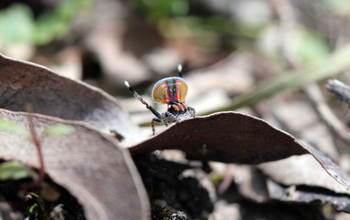Multimedia Gallery
Male Maratus volans jumping spider
A male Maratus volans jumping spider puts on a display for a female.
More about this image
The peacock spider Maratus Volans has one of the most elaborate courtship displays in arthropods.
Researcher by Madeline B. Girard in the Department of Environmental Science, Policy and Management at the University of California, Berkeley, and colleagues used regular and high-speed video segments captured in the lab to obtain detailed descriptions of complete male courtship dances.
Research on jumping spiders has demonstrated that males of some species produce vibrations concurrently with visual displays. The researchers also used laser vibrometry to uncover such elements of the species. Their recordings reveal and describe for the first time that M. Volans males use vibratory signals in addition to complex body ornaments and motion displays in courtship.
The peacock spider and other closely related species are outstanding study organisms for testing hypotheses about the evolution and functional significance of complex displays. Therefore, this descriptive study established a new model system for behavioral ecology, one that could make important contributions to the field.
The research was supported by the National Science Foundation (NSF) (grant IOS 10-21385) and an NSF Graduate Research Fellowship (grant OISE 11-07516).
Read more about this research in the journal story Multi-Modal Courtship in the Peacock Spider, Maratus volans. (Date image taken: November 2011; date originally posted to NSF Multimedia Gallery: Dec. 18, 2018)
Credit: Madeline Girard, Ph.D., University of California, Berkeley
Images and other media in the National Science Foundation Multimedia Gallery are available for use in print and electronic material by NSF employees, members of the media, university staff, teachers and the general public. All media in the gallery are intended for personal, educational and nonprofit/non-commercial use only.
Images credited to the National Science Foundation, a federal agency, are in the public domain. The images were created by employees of the United States Government as part of their official duties or prepared by contractors as "works for hire" for NSF. You may freely use NSF-credited images and, at your discretion, credit NSF with a "Courtesy: National Science Foundation" notation.
Additional information about general usage can be found in Conditions.
Also Available:
Download the high-resolution JPG version of the image. (7.1 MB)
Use your mouse to right-click (Mac users may need to Ctrl-click) the link above and choose the option that will save the file or target to your computer.

